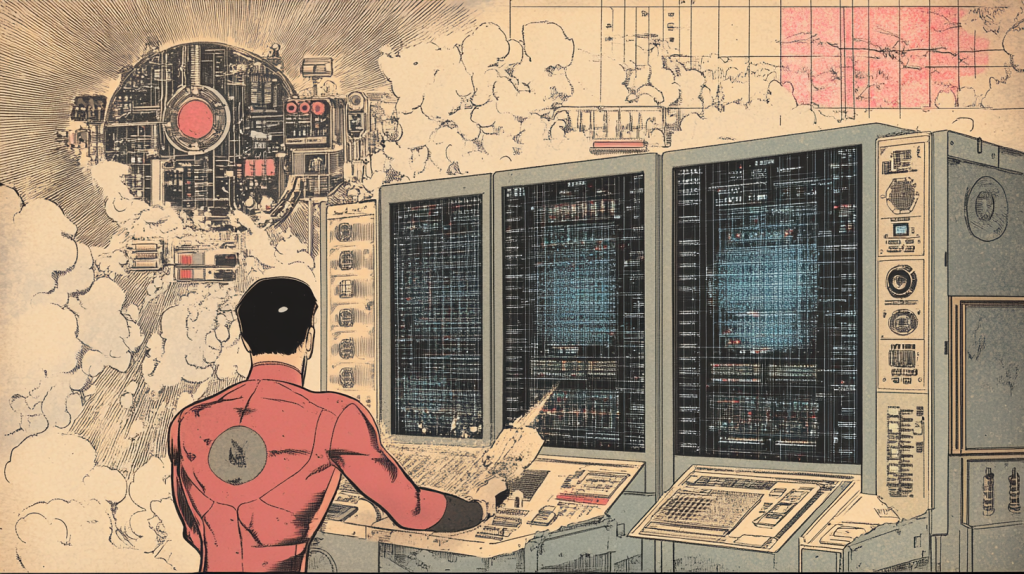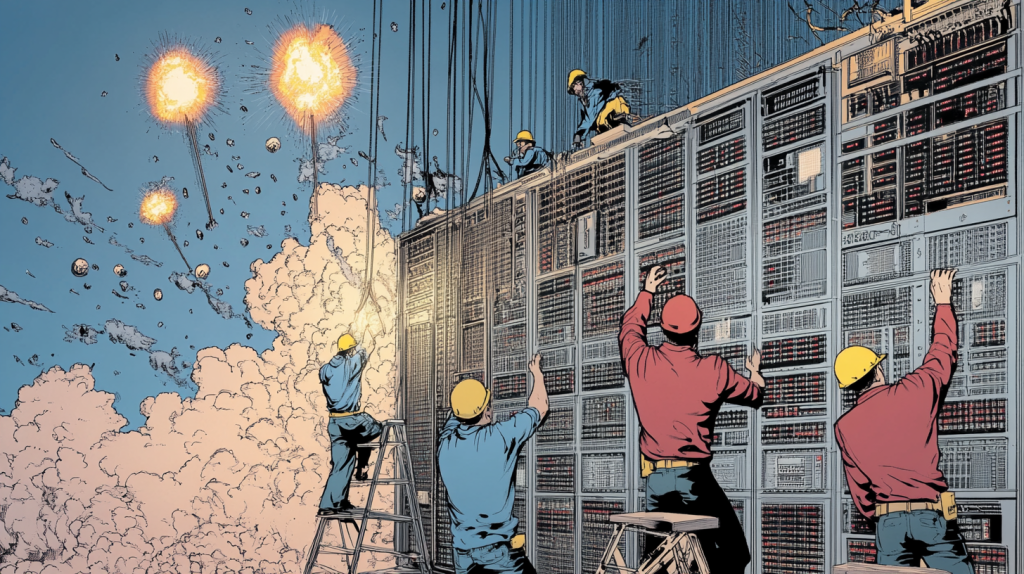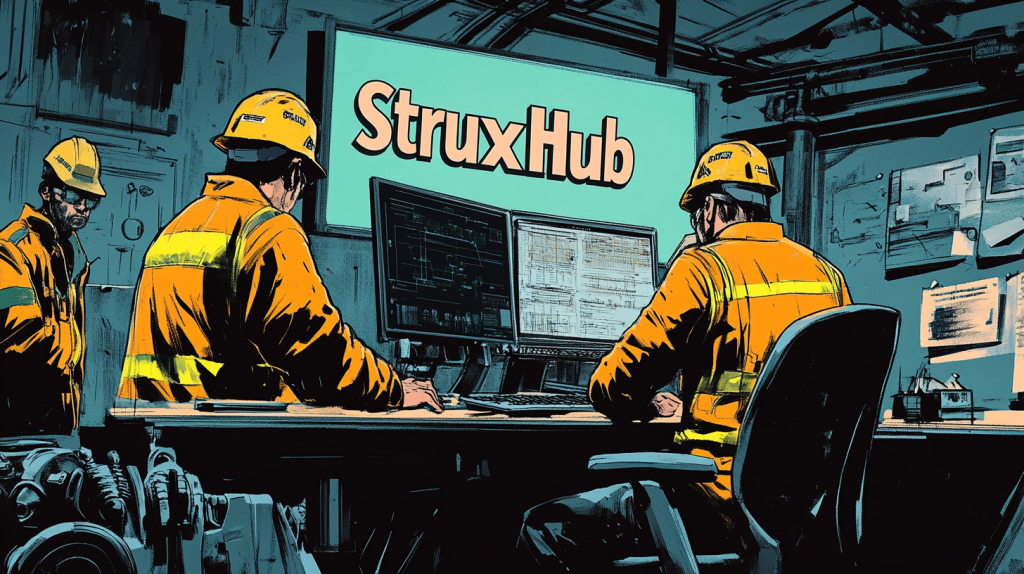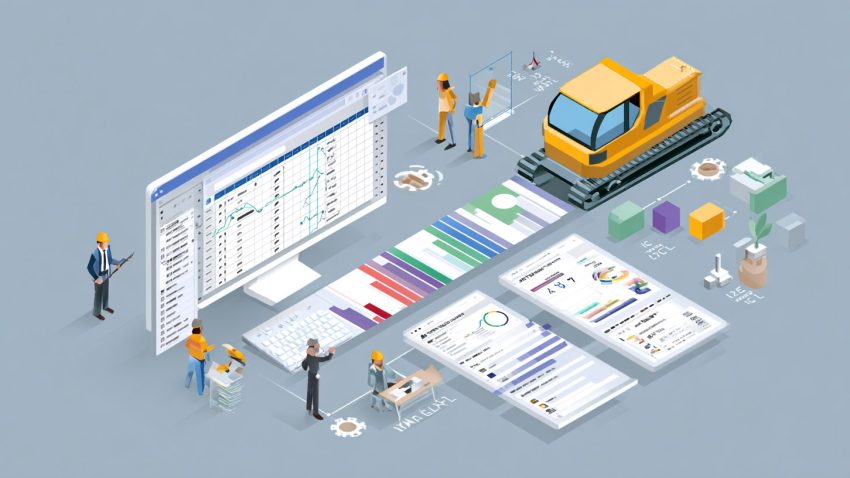Data Center Construction Field Operations Management: Optimize Efficiency & Remote Coordination
Table of Contents:

Managing crew operations in data center construction is a high-stakes challenge—especially in remote locations where logistics, communication, and workforce coordination require precise execution. Unlike traditional construction sites, data centers have strict security protocols, specialized labor requirements, and complex multi-phase schedules, making field operations management even more demanding.
When crews aren’t aligned with project timelines, delays happen. When remote teams lack real-time communication tools, errors multiply. And when project coordination is left to outdated spreadsheets, chaos takes over. That’s why streamlined scheduling, real-time communication platforms, and digital workforce management tools are essential for keeping data center construction projects on track and fully optimized.
This guide will break down the best strategies for managing construction crews, improving field operations, and ensuring seamless coordination in remote data center projects.
Why Crew Management is Critical in Data Center Construction
Data center construction isn’t your typical building project—it requires precisely scheduled tasks, highly skilled labor, and strict compliance with security and operational standards. Unlike general commercial construction, where delays might result in minor financial setbacks, delays in data center builds can mean millions of dollars in lost revenue for cloud providers, enterprises, and colocation facilities.
One of the biggest challenges in crew management is scheduling the right teams at the right time. If electrical crews arrive before backup power systems are delivered, they sit idle. If HVAC teams show up before cooling infrastructure is installed, progress halts. These inefficiencies lead to budget overruns, wasted labor hours, and frustrated contractors.
With the right crew management strategies, superintendents and project managers can ensure:
- Seamless workforce scheduling across multiple job sites.
- Fewer scheduling conflicts between trade teams.
- Optimized labor costs through better allocation of resources.
Key Benefits
- Prevents bottlenecks and scheduling conflicts.
- Improves labor efficiency by ensuring crews are deployed strategically.
- Reduces downtime and delays in remote projects.
Best Practices
- Use real-time scheduling software to track crew availability and shift changes.
- Integrate mobile workforce management tools to improve on-site communication.
- Align construction phases with crew assignments to avoid wasted labor hours.
By optimizing crew management, data center construction teams can keep projects on track, minimize downtime, and ensure every team is where they need to be, exactly when they need to be there.
Related Articles:
Sustainable Data Center Construction: Best Green Building Practices for Sustainable and Mission-Critical Data Center Construction
Data Center Construction Compliance: Top Tools for Streamlining Permits and Compliance in Data Center Construction
Data Center Construction Delivery Coordination: Efficient Scheduling Strategies for Modular Data Center Equipment Installations

Overcoming Remote Project Coordination Challenges
Coordinating construction projects in remote locations comes with unique challenges—limited infrastructure, unreliable communication networks, and workforce logistics make it harder to keep teams aligned. When crews operate across multiple job sites, without a centralized coordination system, delays and inefficiencies become unavoidable.
Common challenges in remote data center projects include:
- Poor connectivity affecting communication between teams and HQ.
- Delays in material deliveries due to supply chain disruptions.
- Labor shortages caused by difficulties in deploying skilled workers to remote sites.
To solve these challenges, superintendents and project managers must implement:
- Cloud-based project coordination platforms to enable real-time updates.
- Satellite communication tools to keep remote teams connected.
- Logistics tracking software to improve material delivery timelines.
Platforms like StruxHub Scheduling help superintendents track crew movements, adjust schedules dynamically, and ensure remote teams stay connected to project HQ.
Key Benefits
- Improves visibility into remote workforce operations.
- Enhances real-time collaboration between job sites and management teams.
- Reduces logistics-related project delays.
Best Practices
- Deploy mobile-friendly workforce management apps for remote teams.
- Use live tracking for deliveries and crew check-ins.
- Schedule weekly virtual coordination meetings to keep teams aligned.
With proper coordination tools and strategic workforce planning, remote data center projects can run smoothly and efficiently, even in challenging environments.

Real-Time Scheduling for Crew and Equipment Allocation
Managing crew schedules and equipment availability in data center construction is a high-stakes operation. If key trades—electricians, HVAC teams, or IT infrastructure installers—aren’t scheduled at the right time, entire project phases can stall, leading to costly delays and inefficiencies. Add to that the challenge of coordinating heavy equipment like cranes, generators, and prefabricated modular units, and scheduling becomes a logistical balancing act.
Why Real-Time Scheduling is a Game-Changer
Traditional static scheduling often fails because it doesn’t account for unexpected disruptions, like weather delays, crew absences, or material delivery setbacks. With real-time scheduling software, superintendents can adjust workforce and equipment assignments dynamically, preventing idle time and optimizing labor productivity.
For example, if a generator delivery is delayed, the crew scheduled for its installation can be reassigned to another task in seconds. If a crane is needed on multiple job sites, real-time tracking ensures it’s scheduled exactly when required, reducing costly rental fees.
Key Benefits
- Reduces crew idle time by dynamically adjusting work assignments.
- Optimizes equipment use, preventing unnecessary rental and storage costs.
- Improves response time to delays, keeping projects on track.
Best Practices
- Use cloud-based scheduling tools to track workforce availability in real time.
- Align crew and equipment schedules to prevent bottlenecks.
- Enable mobile alerts to instantly notify teams of schedule changes.
Real-time scheduling gives superintendents and project managers full visibility into workforce and equipment availability, allowing for rapid adjustments and greater project efficiency.
Related Articles:
Best Guide to Data Center Construction Management Software: Manage Scheduling, Deliveries, and Compliance for Hyperscale Projects
Data Center Construction Deliveries: Best Real-Time Tracking Solutions for Managing Data Center Construction Deliveries
Data Center Construction: Top Delivery and Scheduling Strategies for Redundant Power Systems in Data Centers
Using AI for Predictive Scheduling and Workforce Optimization
Artificial Intelligence (AI) is revolutionizing data center construction scheduling, bringing predictive capabilities that eliminate inefficiencies, reduce delays, and optimize workforce allocation. Instead of reacting to schedule changes, AI anticipates potential disruptions before they happen.
How AI Enhances Scheduling Efficiency
- Predicts Workforce Availability – AI can analyze historical labor data to anticipate crew shortages, allowing project managers to adjust hiring or reallocate resources proactively.
- Optimizes Shift Planning – AI suggests ideal shift rotations based on worker fatigue patterns, workload balancing, and productivity trends.
- Reduces Material Delays – AI-powered logistics forecasting identifies high-risk delays in material deliveries, enabling real-time rescheduling to prevent workforce downtime.
- Automates Compliance Checks – AI ensures that crew assignments follow safety and certification requirements, preventing non-compliance issues before they arise.
Key Benefits
- Increases scheduling accuracy by using predictive analytics.
- Reduces crew over-scheduling, minimizing overtime costs.
- Enhances labor productivity by optimizing shift assignments.
Best Practices
- Integrate AI scheduling tools with workforce management platforms.
- Use AI-driven risk analysis to prevent bottlenecks in critical project phases.
- Automate workforce forecasting to anticipate crew shortages and skill gaps.
By leveraging AI, data center construction teams gain deeper insights into workforce efficiency, enabling better planning, reduced costs, and faster project completion.

Improving Safety and Compliance in Data Center Crew Management
Ensuring worksite safety and regulatory compliance is one of the biggest priorities in data center construction. These projects involve high-voltage electrical work, heavy machinery operations, confined spaces, and remote work conditions, all of which come with significant safety risks.
Common Crew Safety Challenges
- High-Risk Electrical Work – Data centers require complex electrical installations, meaning crews must follow strict OSHA and NFPA 70E safety standards to avoid hazards like arc flashes and electrical fires.
- Remote Job Sites – Many data center projects are in isolated locations, making emergency response and worker communication more difficult.
- Heavy Equipment Use – Cranes, generators, and cooling towers require proper crew training and compliance with load-bearing safety standards.
How to Improve Safety and Compliance
- Use Digital Safety Checklists – Implementing daily digital safety logs ensures that all crew members comply with PPE and risk mitigation protocols.
- Conduct AI-Powered Risk Assessments – AI can analyze site data to identify high-risk work areas, preventing accidents before they occur.
- Leverage Remote Safety Monitoring – IoT-connected devices and wearables track worker movements, detect falls, and provide emergency alerts.
Key Benefits
- Prevents injuries and liability issues by enforcing compliance.
- Improves emergency response in remote job sites.
- Reduces OSHA violation risks and regulatory fines.
Best Practices
- Schedule mandatory safety briefings before every shift.
- Use AI-driven compliance tracking to monitor safety protocols.
- Equip remote teams with emergency communication tools.
By implementing proactive safety measures and compliance tracking, data center crews can work more efficiently while minimizing risks, delays, and regulatory penalties.
The Role of Digital Twins in Remote Data Center Operations
Digital twin technology is changing how data center construction teams manage remote job sites, providing real-time virtual models that improve monitoring, scheduling, and coordination.
What is a Digital Twin?
A digital twin is a real-time, AI-powered replica of a physical construction site that captures live data from sensors, workforce activity, and equipment operations. This enables remote managers to oversee construction progress, track crew movements, and optimize workflows without being physically on-site.
How Digital Twins Improve Crew Management
- Real-Time Site Visualization – Allows superintendents to monitor job sites remotely, reducing the need for frequent on-site visits.
- Automated Scheduling Adjustments – AI-driven models suggest schedule optimizations based on live construction data.
- Predictive Maintenance for Equipment – Identifies potential equipment failures before they disrupt construction.
Key Benefits
- Enhances remote project visibility for superintendents and managers.
- Improves scheduling accuracy by aligning real-world progress with project timelines.
- Reduces logistical inefficiencies by tracking crew and equipment movement.
Best Practices
- Use AI-integrated digital twins for real-time workforce tracking.
- Automate progress reports based on live site data.
- Implement digital twin models to improve crew scheduling efficiency.
By leveraging digital twin technology, remote data center teams can reduce manual oversight, improve scheduling accuracy, and optimize overall project efficiency.
Related Articles:
Best Guide to Construction Management Software
Data Center Construction Delivery Coordination: Efficient Scheduling Strategies for Modular Data Center Equipment Installations
The Best Guide to Delivery Management Systems (DMS) for Commercial Construction
Superintendents: Effective Training Strategies for Construction Management Software Users
Automating Workforce Reporting for Better Project Oversight
Workforce reporting is essential for tracking crew productivity, labor costs, and compliance requirements in data center construction. However, manual reporting processes can be time-consuming, error-prone, and difficult to manage across multiple job sites.
How Automation Enhances Workforce Reporting
- Real-Time Crew Productivity Tracking – Automates shift logs, ensuring accurate reporting on work hours and task completion.
- Instant Compliance Documentation – Generates automated safety and labor reports to meet OSHA, NFPA, and local regulatory standards.
- Predictive Workforce Analytics – Uses AI to forecast labor needs and optimize crew scheduling.
Key Benefits
- Reduces administrative workload for superintendents.
- Improves data accuracy and eliminates manual errors.
- Enhances project oversight with real-time workforce metrics.
Best Practices
- Implement automated time-tracking systems.
- Use mobile workforce apps for instant shift reporting.
- Generate AI-powered workforce analytics for better decision-making.
By automating workforce reporting, data center teams can increase efficiency, ensure compliance, and improve overall project oversight.
What tools can improve field operations management in data center construction?
Field operations in data center construction involve coordinating multiple teams, tracking progress across job sites, and ensuring real-time communication between superintendents and crew members. Using the right technology tools is essential for keeping large-scale projects running smoothly.
Top Field Operations Management Tools for Data Center Projects:
- StruxHub Scheduling – Helps project managers track workforce availability, assign tasks dynamically, and prevent scheduling conflicts.
- Procore – A comprehensive project management software that integrates document tracking, safety compliance, and communication tools.
- Plangrid – Used for field documentation and real-time blueprint sharing, ensuring that crews always have updated project specs.
- GPS and RFID Tracking Systems – Improves crew and equipment tracking for remote job sites.
- AI-Based Predictive Analytics – Provides real-time workforce insights to optimize scheduling and prevent bottlenecks.
Key Benefits
- Improves communication and coordination across multiple job sites.
- Reduces time wasted on manual workforce tracking and scheduling.
- Enhances project visibility and reduces compliance risks.
Best Practices
- Implement real-time workforce tracking using mobile-friendly apps.
- Integrate crew scheduling with job site reporting tools.
- Automate compliance tracking and documentation for regulatory approvals.
By leveraging advanced field operations management tools, data center construction teams can eliminate inefficiencies, improve project oversight, and keep remote job sites fully coordinated.
Unlock the Full Potential of Your Construction Projects with StruxHub
StruxHub enhances efficiency and coordination across all project phases, providing a single source of truth that eliminates silos and fosters collaboration. Real-time updates, financial management tools, and seamless commvunication features ensure that all team members and stakeholders are aligned and informed, reducing the risk of errors and delays. With comprehensive solutions for document management, risk mitigation, and quality control, StruxHub maintains project integrity and safety, while mobile access and integration capabilities further enhance project flexibility and efficiency.
StruxHub’s Key Features and Benefits:
- Advanced Delivery Management: Automate and optimize your delivery schedules, ensuring materials arrive just in time, every time.
- Site Communication: Utilize georeferenced maps and instant messaging to keep every team member informed and aligned.
- Construction Materials Management: Track inventory levels and manage materials procurement with ease, reducing waste and avoiding project delays.
- Construction Safety & Inspection Workflows: Implement customizable mobile forms for conducting safety inspections and managing compliance documentation effortlessly.
- Short-Term Scheduling: Visualize project tasks with detailed floor plans, linking each activity to specific locations for better planning accuracy.
- Construction Resource Management: Efficiently allocate personnel and equipment, maximizing productivity and reducing idle time.
StruxHub’s Product Offering:
- StruxHub Deliveries: Simplifies the coordination of incoming deliveries, ensuring materials and equipment are precisely timed to project needs.
- StruxHub Logistics: Offers intelligent site logistics planning, from crane scheduling to space allocation, for smoother operations.
- StruxHub Safety: Elevates on-site safety standards with easy-to-use tools for inspections, permits, and incident reporting.
- StruxHub Scheduling: Enhances project timelines with intuitive scheduling tools that ensure tasks are completed efficiently and on time.
With StruxHub, construction companies can look forward to a streamlined, more efficient project execution that delivers on time and within budget. Embrace the power of innovation and take your construction projects to the next level.
Don’t miss out on the opportunity to optimize your construction management processes with StruxHub. Sign up for a free demo today. Let’s build smarter, together.

StruxHub
Experience the power of StruxHub today and witness firsthand how it can revolutionize your construction operations.
FAQ
Why is workforce coordination critical for remote data center projects?
Managing workforce coordination in remote data center construction is challenging due to limited infrastructure, difficult communication logistics, and unpredictable environmental conditions. Unlike urban construction sites, remote projects require advanced planning, seamless scheduling, and real-time workforce tracking to ensure efficiency.
One of the biggest issues with remote projects is crew accessibility. If workers are stationed far from supply hubs or transport routes, it can lead to extended travel times and delays in shift rotations. This makes precise scheduling essential to avoid idle time, maximize productivity, and ensure each crew is assigned to a task they can complete efficiently.
Another challenge is supply chain disruptions. Delivering heavy equipment, prefabricated data center modules, and power infrastructure to remote sites requires logistics tracking and predictive scheduling to prevent delays. If materials don’t arrive on time, labor teams are left waiting, driving up costs and pushing back deadlines.
To counter these challenges, project managers should use AI-driven scheduling platforms, implement satellite communication systems, and leverage mobile workforce management apps to keep teams aligned. Platforms like StruxHub Scheduling allow teams to track workforce movements, adjust schedules dynamically, and ensure remote teams stay connected to project HQ.
By implementing these strategies, superintendents and field managers can eliminate coordination issues, improve productivity, and ensure that remote data center projects stay on schedule.
How can real-time scheduling improve crew efficiency in data center construction?
Real-time scheduling ensures that construction crews, subcontractors, and equipment operators are assigned tasks in alignment with project timelines, material availability, and shifting priorities. Without real-time updates, scheduling is static and inefficient, leading to delays, crew idling, and misallocated resources.
A major issue in large-scale data center construction is crew overlap—when multiple trade teams are scheduled for the same space at the same time, causing bottlenecks. For example, if electricians and HVAC installers are assigned to the same server hall simultaneously, their work can conflict, slowing down both teams. Real-time scheduling prevents this by dynamically adjusting work assignments based on site readiness and material deliveries.
Another challenge is last-minute changes due to weather, supplier delays, or labor shortages. If a truck carrying backup power generators is delayed, the team assigned to install them should be reassigned to another high-priority task. Real-time scheduling software ensures that workers aren’t waiting around and that construction timelines remain flexible.
Superintendents using real-time workforce management software can track crew assignments, receive live updates, and reschedule shifts instantly. Platforms like StruxHub Scheduling integrate mobile alerts and cloud-based coordination tools, ensuring that every worker knows their assigned task and any schedule changes in real-time.
By optimizing crew efficiency with real-time scheduling, data center projects experience fewer delays, lower labor costs, and improved project oversight.
What are the biggest challenges in remote construction workforce management?
Remote data center projects face several workforce management challenges, including logistics difficulties, communication gaps, limited access to skilled labor, and unpredictable weather conditions. These factors make crew deployment, task assignments, and shift scheduling far more complex than urban or suburban construction projects.
One of the primary issues is crew mobility. Unlike city-based job sites where workers can easily commute, remote data center projects often require long travel times, temporary housing for workers, and carefully planned shift rotations. Managing these logistics effectively requires predictive workforce planning and real-time crew tracking.
Another major challenge is lack of real-time communication. Remote locations often have poor cellular service or unreliable internet, making it difficult for field teams to coordinate with HQ, update schedules, or report on-site issues. To overcome this, project managers should invest in satellite-based communication tools, mobile-friendly workforce apps, and cloud-based reporting systems.
Additionally, weather and environmental factors play a significant role. If a construction site experiences severe storms, extreme heat, or equipment malfunctions, crews may be forced to halt work unexpectedly. Using weather-integrated scheduling software allows managers to anticipate disruptions and adjust workforce assignments accordingly.
By implementing mobile workforce management platforms, AI-driven scheduling tools, and GPS tracking for labor teams, construction firms can reduce inefficiencies, improve communication, and keep remote projects running smoothly.
How does AI help in optimizing workforce planning for data center projects?
Artificial intelligence (AI) is revolutionizing workforce planning in data center construction by predicting scheduling conflicts, optimizing labor allocation, and improving productivity tracking. AI-powered software analyzes historical labor data, real-time crew movements, and job site conditions, providing intelligent scheduling recommendations that reduce delays and improve efficiency.
For example, AI can analyze workforce performance trends to determine when crews are most productive and schedule shifts accordingly. If AI detects that HVAC specialists are most efficient in morning shifts, while electrical teams work best at night, scheduling can be optimized to maximize daily output.
AI also forecasts labor shortages and crew availability. If multiple projects in a region require specialized electrical engineers, AI can predict demand spikes and recommend workforce adjustments before shortages occur. This ensures that projects never fall behind due to lack of skilled labor.
Another major advantage is automated workforce reallocation. If AI detects that a team is ahead of schedule, it can automatically reassign those workers to another high-priority task, improving efficiency across the entire project. AI-based tools like StruxHub Scheduling integrate predictive workforce analytics to help construction teams stay agile and responsive.
By incorporating AI-driven workforce planning, data center construction firms reduce labor waste, improve scheduling accuracy, and increase overall project efficiency.




